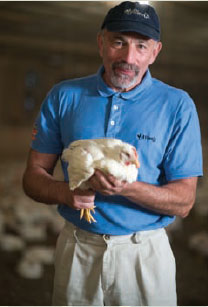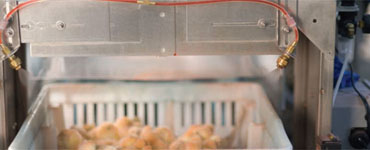
Banking on Experience
 "It was chronic"
"It was chronic"
Dr. Gladys
No one ever said producing broilers in Sussex County, Delaware, would be easy. Between extremes in the weather and a dense bird population — over 200 million produced annually within 938 square miles, more than any other county in the nation — birds are highly susceptible to disease.
Gumboro disease and runting-stunting
syndrome, for instance, are not uncommon
in the area. What came as an unexpected
development, though, was an outbreak of
gangrenous dermatitis at Allen Family
Farms in early 2007. And oddly enough, the
solution for the costly skin disease was
improved intestinal health.
“Dermatitis was affecting from eight to 10
birds per 1,000, and 30 to 40 houses a week
were breaking with it. On some of the
farms, it was chronic — flock after flock,”
reports Gary Gladys, PhD, vice president of
live operations for Allen, which is located
in Seaford and is the 15th-largest poultry
producer in the US.
Although gangrenous dermatitis was
unique at Allen Family Farms, it is not a
rare occurrence in the poultry industry.
The disease has become a major health
concern in broiler flocks throughout the
US, often resulting in high mortality,
carcass condemnations and trimmed
parts. Another reason gangrenous
dermatitis results in heavy economic
losses is because most birds are affected
late in their short lives — after 4 weeks of age — at a time they should be experiencing
the fastest growth spurt and when
feed consumption is highest.
Gangrenous dermatitis has numerous
signs, including loss of appetite,
gangrenous skin, cellulitis and mortality.
One report published in Poultry USA
estimated that economic losses from
the disease run as high as $1.31 per
affected bird.1
On Allen’s farms, birds with dermatitis
were treated with antibiotics and most
recovered, despite losses in performance.
Some birds died.
Gladys, who joined Allen about 3 years ago,
had an idea about how to indirectly manage
the onslaught of dermatitis based on past
experience at another US poultry company:
coccidiosis vaccination.
At the other company, Coccivac-B liveoocyst
vaccine was used year-round for
organic broilers and was rotated with
anticoccidials for a large portion of the
antibiotic-free broilers. For whatever
reason, “We never would see dermatitis in
the birds on Coccivac-B vaccine,”
Gladys says.
Although Gladys was eager to implement
coccidiosis vaccination at Allen Family
Farms, not all of Allen’s broiler grow-out facilities — about 500 independent
operations, plus 28 company-owned
farms — were ready to buy into the idea,
especially since in-feed anticoccidials
seemed to be working well.
A few of Allen's farms, however, took
the plunge and started vaccinating with
Coccivac-B starting in April 2007. As
Gladys anticipated, the incidence of
dermatitis dropped significantly. In
fact, on most of the farms vaccinating,
dermatitis disappeared altogether,
he says.

Advances in administration methods
help ensure that all chicks are vaccinated
for coccidiosis.
Other than switching to a coccidiosis
vaccine, no changes were made that
could account for the mysterious but
welcomed disappearance of dermatitis.
Vaccinated birds, for instance, received
the same diets as Allen’s other birds,
Gladys says.
USE OF VACCINE SOARS
The reduction of dermatitis on Allen
farms was so significant that, by the next
round of birds, “everyone was jumping
on board,” he says. Every week Allen
vaccinated about 800,000 broilers with
Coccivac-B — close to one-third of the
2.5 million birds that it processes weekly.
“We started out just suggesting use of the
vaccine; by the middle of summer, all of
Allen’s service reps wanted their flocks on
the vaccine,” Gladys says.
Feed conversion in the vaccinated birds
has been the same as conventionally raised
birds, and by decreasing dermatitis, the
high cost of production was improved, he
says. In addition, routine posting sessions
indicated good coccidiosis control.
Performance with the coccidiosis vaccine
was consistent with Gladys’s previous
experience at the other poultry company.
“There we had antibiotic-free and conventional birds on the same farm
but in different houses,” he says. “The
performance of coccidiosis-vaccinated
birds was the same as conventional birds.
Antibiotic-free birds had slightly higher feed
conversion, but I don’t think it had anything
to do with the coccidiosis vaccine.”
Is coccidiosis vaccination cost-effective?
“Yes, certainly more so than feeding
salinomycin” if you look at the long-term
results, Gladys says. There’s more to
consider than the initial cost of vaccination.
Asked why he thinks dermatitis stopped
after initiating coccidiosis vaccination,
Gladys pauses and then freely admits that
he doesn’t know for sure. He’s aware of
one theory, however.
Dermatitis is thought to be caused by the
bacterium Clostridium perfringens, an
opportunistic infection also linked to
necrotic enteritis. One supposition is that
when in-feed anticoccidials begin to lose
their effectiveness — even when it’s not
noticeable — “leakage” of coccidiosiscausing
Eimeria organisms occurs.
That results in coccidiosis breaks and
an unhealthy gut, setting the stage for
C. perfringens to take over. The detrimental
effect of anticoccidial leakage is worse
when it occurs late in the growout cycle —
after 28 days of age — which is the
same time that gangrenous dermatitis
usually strikes.

Chicks are showered with Coccivac-B in the hatchery to stimulate natural immunity
against coccidiosis.
Coccidiosis vaccination stimulates the
bird’s natural immune system to provide
lifetime coccidiosis control and, by
doing so, results in a healthier gut, so
C. perfringens can’t get a foothold (see
sidebar on page 23). Furthermore, because
coccidiosis vaccination is applied at 1 day
of age, birds are fully immune to coccidiosis
by 4 weeks of age.
Gladys, however, says that before
coccidiosis vaccination was implemented,
Allen maintained excellent coccidiosis
control by rotating in-feed anticoccidials.
To keep a close eye on its program, the
company turns to technical service
representatives from various animal health
companies who necropsy six birds from
35 flocks every 8 weeks and score them
for lesions. The team includes
Intervet/Schering-Plough Animal Health’s
parasitologist Dr. Steve Fitz-Coy, who
maintains a diagnostic laboratory near the
company’s Coccivac-B manufacturing plant
in nearby Millsboro, Delaware.
“We’ve been doing this for many years and
we rotate anticoccidials based on findings
in the posting sessions. We don’t wait until
our anticoccidials poop out before we make
a change,” Gladys says.
Impressed by initial
results, all of Allen’s
farms started using the
vaccine this year and
will continue to do so
until December, when
they will switch back to
in-feed anticoccidials.
He agrees though that the disappearance
of dermatitis after coccidiosis vaccination
could simply have occurred because
Coccivac-B vaccine contributes to a
healthier gut.
Impressed by initial results, all of Allen's
farms started using the vaccine this year
and will continue to do so until December,
when they will switch back to in-feed
anticoccidials.
By the end of December, Gladys expects
the houses to be “seeded down” with
oocysts from Coccivac-B, which are highly
sensitive to in-feed anticoccidials, he says.
This allows Allen to rotate back to traditional
in-feed anticoccidials in the winter
months before returning to vaccination in
the spring.
BROODING MANAGEMENT
CRUCIAL
One important factor contributing
to Allen’s newfound enthusiasm for
coccidiosis vaccination was a presentation
provided by Dr. Matilde Alfonso, technical
service veterinarian with Intervet/
Schering-Plough Animal Health, about
how coccidiosis vaccination works. “It was
a real eye-opener,” Gladys says.
A crucial point Alfonso emphasized was
the need to provide the full house to
z z
coccidiosis-vaccinated birds in half-house
brooding by 14 days of age. “It’s one of
those things that gets easily overlooked,”
he says (see sidebar on pages 25-26).
Despite great results with coccidiosis
vaccination and although Gladys says that
“I’ve seen coccidiosis vaccination work in
organic birds year-round,” Allen plans to
keep rotating coccidiosis vaccination with
anticoccidials.
Come winter, wind makes it difficult to keep
birds warm. In addition, ventilation is less
than ideal, and it’s hard to keep litter dry. In
birds vaccinated with Coccivac-B, about
25% litter moisture is needed to stimulate
the coccidial life cycle, but excessive litter
moisture promotes heavy cycling and too
much coccidia reaction in birds. These
problems make Allen more comfortable
using in-feed anticoccidials during
cold months.
TRANSITION TO VACCINE EASY
Introducing coccidiosis vaccination in
"We started out just
suggesting use of the
vaccine; by the
middle of summer, all
of Allen’s service reps
wanted their flocks
on the vaccine."
the spring, however, was a breeze, Gladys
says, adding that “it was a really nice
transition” for the hatchery.
Day-old chicks are vaccinated with
Coccivac-B vaccine via a Spraycox II
unit, which has dual nozzles for more uniform distribution. Red dye is included
in the vaccine mix to encourage preening
and ingestion of the vaccinal oocysts,
which stimulate the chicks’ immunity.
Halogen lamps are used to further
encourage preening and to help dry the
birds and prevent them from getting
chilled, he says.
Making the switch at the feed mill was
not a problem, either. Allen’s feed mill,
located in nearby Delmar, Maryland,
produces over 28 million pounds of feed
(more than 12.7 million kilograms) per
week, and a second feed mill is underway
in Sussex County to provide feed for
5 million company broilers located within
a 10-mile radius of the new mill.
To ensure that coccidiosis-vaccinated
birds do not accidentally get feed with
anticoccidials, feed for vaccinated
chicks is colored red with iron oxide for
easy identification.
“Red spots, red feed,” Gladys quips,
referring to the red dye sprayed on birds
with vaccination at the hatchery and the
colored feed.
Initiating coccidiosis vaccine requires
preplanning, Gladys says, but “it just comes
down to whether you want something to
work or not.”
Back to North American Edition (#2)


 Advances in administration methods
help ensure that all chicks are vaccinated
for coccidiosis.
Advances in administration methods
help ensure that all chicks are vaccinated
for coccidiosis. Chicks are showered with Coccivac-B in the hatchery to stimulate natural immunity
against coccidiosis.
Chicks are showered with Coccivac-B in the hatchery to stimulate natural immunity
against coccidiosis.







